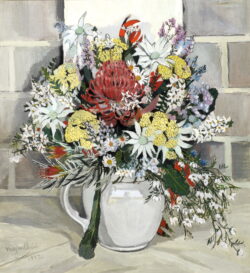 There are several famous female artists in the Hinton Collection who were working in the early part of the twentieth century (1900’s). Most of their work falls into the category of genre painting. This is a term used to describe work that displays scenes of everyday life and ordinary people in work or relaxing activities, painted in a realistic manner.
There are several famous female artists in the Hinton Collection who were working in the early part of the twentieth century (1900’s). Most of their work falls into the category of genre painting. This is a term used to describe work that displays scenes of everyday life and ordinary people in work or relaxing activities, painted in a realistic manner.
Earlier generations of female artists, like those associated with the Australian Impressionists in the late nineteenth century (1800’s), such as Jane Sutherland and Jane Price, were limited by the restrictions placed on women at the time. They couldn’t stay at the artist’s camps with the men and only visited for day trips. The amount of time painting was often limited by having to support themselves in other ways financially and because of this, they enjoyed far fewer successes in their lifetimes than their male counterparts.
In comparison, the next generation of women artists gained far greater recognition, sold their work in exhibitions, taught art, began art societies and teaching studios, were appointed war artists and won prestigious art awards. In the early decades of the twentieth century (1900’s), roles for women were radically changing. Women worldwide were given new opportunities to lead active and independent positions in society because of the impact of the First and Second World Wars.
In the early part of the twentieth century (1900’s), there was a shortage of labour as men enlisted to fight in WWI (1914-18) and WWII (1938-45). Traditional male jobs, previously seen as too physically or intellectually challenging for women, were now opened up to the female population. Women took up positions in industry, agriculture, factories, offices as well as armed forces, to fill jobs left by men.
These women gained new skills, experience, income and independence away from traditional homemaking tasks.
After the war, many women found themselves put back in the home as men returned from the war and to civilian life. However, the experience of the wars forever transformed the roles of women in Australian society. Many women like the artists in the Hinton collection built on this independence to lead successful and self-determining careers.
Research one of the female Hinton Collection artists from the list below:

Ethel Spowers (1890-1947)
Ester Paterson (1892-1971)
Nora Heysen (1911-2003)
Margaret Preston (1875-1963)
Guiding questions
What were the subjects and themes in their work? Why do you think they chose these subjects?
Choose a work from the artist. If the image is a landscape or has figures in it, describe what is happening in the work. From the visual information in the picture, imagine a story about what is happening.
Traditional roles for women often centred on family and the home. How and why were traditional roles for women changing in the early decades of the twentieth century (1900’s)? Outside of painting in the studio, what roles did these female artists take up in their lives? How do you think society felt about women working as artists?
Female artist’s work was (and still is) often sold at a lower price than male artists. What could be the reasons for this?
Image credits:
Margaret Preston, Australian Flowers, 1932, oil on canvas, Gift of Howard Hinton Collection 1935, The Howard Hinton Collection
Ethel Spowers, The Timber Crane, 1926, colour linocut, Gift of Howard Hinton 1936, The Howard Hinton Collection
Esther Paterson, Self portrait, 1935, oil on canvas, Acquisition supported with funds from the Visual Arts Board 1988, NERAM Collection
Nora Heysen, Still Life, 1933, oil on canvas, Gift of Howard Hinton 1933, The Howard Hinton Collection
Margaret Preston, A Darwin Bunch, 1940, oil on canvas, Gift of Howard Hinton Collection 1943, The Howard Hinton Collection
This program was funded by the NSW Government.
